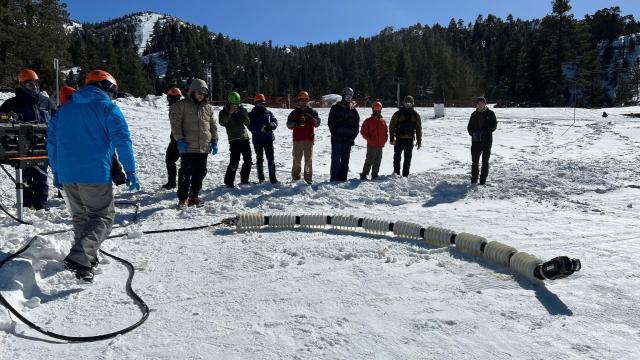A new robot has joined NASA’s collection of odd mechanical beings that traverse across other planets in search of life. But unlike the usual autonomous machines shaped like SUVs or tiny helicopters, this one is long, slithery — and hella creepy.
A team of engineers from NASA’s Jet Propulsion Laboratory (JPL) has created a snake-shaped robot that can slide its way down through narrow vents beneath the surface of icy worlds, according to the space agency.
“There are dozens of textbooks about how to design a four-wheel vehicle, but there is no textbook about how to design an autonomous snake robot to boldly go where no robot has gone before,” Hiro Ono, EELS principal investigator at JPL, said in the NASA statement. “We have to write our own. That’s what we’re doing now.”
The Exobiology Extant Life Surveyor, or EELS for short, is currently being tested at JPL so that it can one day make its way through various terrains on Earth, the Moon, and Saturn’s moon Enceladus. Scientists believe the icy moon could contain signs of life in its subsurface oceans.
“It has the capability to go to locations where other robots can’t go,” JPL’s Matthew Robinson, EELS project manager, said in the NASA statement. “Though some robots are better at one particular type of terrain or other, the idea for EELS is the ability to do it all.”
The first EELS prototype was built in 2019, and since then the team behind the robot has been conducting field tests every month to refine its software and hardware so that it can operate autonomously. “When you’re going places where you don’t know what you’ll find, you want to send a versatile, risk-aware robot that’s prepared for uncertainty — and can make decisions on its own,” Robinson said.
EELS stretches 4 metres long and weighs about 220 pounds (100 kilograms). The snake-like bot is made up of “10 identical segments that rotate, using screw threads for propulsion, traction, and grip,” NASA wrote in its statement. The robot snake has been tested in different environments with snow, sand, and ice, including the Mars Yard at JPL (a “robot playground” created at a ski resort in Southern California) and at a local indoor ice rink.

NASA engineers designed EELS to autonomously sense its environment and calculate risk, as well as recover on its own. “Imagine a car driving autonomously, but there are no stop signs, no traffic signals, not even any roads. The robot has to figure out what the road is and try to follow it,” Rohan Thakker, the project’s autonomy lead, said in the statement. “Then it needs to go down a 30.48 m drop and not fall.”
EELS is equipped with four pairs of stereo cameras and LiDAR, which uses laser pulses to create a 3D map of its surroundings. The robot uses that map to figure out the safest path forward with its navigation algorithm. The team members will get to decide in the future which science instruments they want their snake robot to have.
“Our focus so far has been on autonomous capability and mobility, but eventually we’ll look at what science instruments we can integrate with EELS,” Robinson said. “Scientists tell us where they want to go, what they’re most excited about, and we’ll provide a robot that will get them there. How? Like a startup, we just have to build it.”
